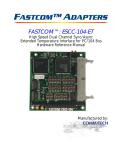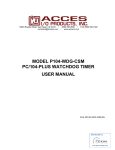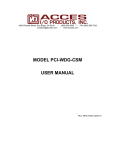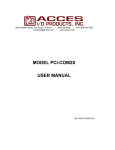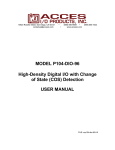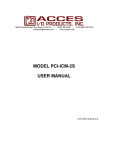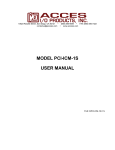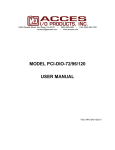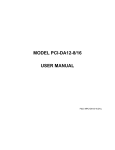Download B&B Electronics PC Watchdog Timer Card ATRWDT User manual
Transcript
10623 Roselle Street, San Diego, CA 92121 • (858) 550-9559 • FAX (858) 550-7322 [email protected] • www.accesio.com MODEL P104-WDG-CSM PC/104-PLUS WATCHDOG TIMER USER MANUAL FILE: MP104-WDG-CSM.B3j Notice The information in this document is provided for reference only. ACCES does not assume any liability arising out of the application or use of the information or products described herein. This document may contain or reference information and products protected by copyrights or patents and does not convey any license under the patent rights of ACCES, nor the rights of others. IBM PC, PC/XT, and PC/AT are registered trademarks of the International Business Machines Corporation. Printed in USA. Copyright by ACCES I/O Products Inc, 10623 Roselle Street, San Diego, CA 92121. All rights reserved. WARNING!! ALWAYS CONNECT AND DISCONNECT YOUR FIELD CABLING WITH THE COMPUTER POWER OFF. ALWAYS TURN COMPUTER POWER OFF BEFORE INSTALLING A CARD. CONNECTING AND DISCONNECTING CABLES, OR INSTALLING CARDS INTO A SYSTEM WITH THE COMPUTER OR FIELD POWER ON MAY CAUSE DAMAGE TO THE I/O CARD AND WILL VOID ALL WARRANTIES, IMPLIED OR EXPRESSED. 2 P104-WDG-CSM User Manual Warranty Prior to shipment, ACCES equipment is thoroughly inspected and tested to applicable specifications. However, should equipment failure occur, ACCES assures its customers that prompt service and support will be available. All equipment originally manufactured by ACCES which is found to be defective will be repaired or replaced subject to the following considerations. Terms and Conditions If a unit is suspected of failure, contact ACCES' Customer Service department. Be prepared to give the unit model number, serial number, and a description of the failure symptom(s). We may suggest some simple tests to confirm the failure. We will assign a Return Material Authorization (RMA) number which must appear on the outer label of the return package. All units/components should be properly packed for handling and returned with freight prepaid to the ACCES designated Service Center, and will be returned to the customer's/user's site freight prepaid and invoiced. Coverage First Three Years: Returned unit/part will be repaired and/or replaced at ACCES option with no charge for labor or parts not excluded by warranty. Warranty commences with equipment shipment. Following Years: Throughout your equipment's lifetime, ACCES stands ready to provide on-site or in-plant service at reasonable rates similar to those of other manufacturers in the industry. Equipment Not Manufactured by ACCES Equipment provided but not manufactured by ACCES is warranted and will be repaired according to the terms and conditions of the respective equipment manufacturer's warranty. General Under this Warranty, liability of ACCES is limited to replacing, repairing or issuing credit (at ACCES discretion) for any products which are proved to be defective during the warranty period. In no case is ACCES liable for consequential or special damage arriving from use or misuse of our product. The customer is responsible for all charges caused by modifications or additions to ACCES equipment not approved in writing by ACCES or, if in ACCES opinion the equipment has been subjected to abnormal use. "Abnormal use" for purposes of this warranty is defined as any use to which the equipment is exposed other than that use specified or intended as evidenced by purchase or sales representation. Other than the above, no other warranty, expressed or implied, shall apply to any and all such equipment furnished or sold by ACCES. 3 P104-WDG-CSM User Manual TABLE OF CONTENTS Chapter 1: Introduction ..................................................................................................................... 5 Watchdog .......................................................................................................................................... 5 Figure 1-1: Block Diagram ........................................................................................................ 6 Watchdog Models ........................................................................................................................... 6 P104-WDG-E: Economy Basic Watchdog ............................................................................ 6 P104-WDG-CSM: Standard Watchdog with Computer Status Monitor ........................ 7 P104-WDG-CSMA: Standard Watchdog with Advanced Computer Status Monitor . 8 Ordering Guide / P1 Connector Configurations ..................................................................... 9 Model Options.................................................................................................................................. 9 Included with your board .............................................................................................................. 9 Chapter 2: Installation...................................................................................................................... 10 Hardware Installation ................................................................................................................... 11 Figure 2-1: Fan Connection Diagram................................................................................... 12 Chapter 3: Address Selection........................................................................................................ 13 Chapter 4: Programming................................................................................................................. 14 Register Definitions...................................................................................................................... 14 Table 4-1: Register Address Map.......................................................................................... 14 Three events will generate an active-low RESET at P1-12: ............................................... 14 Seven events may generate interrupts ................................................................................... 14 82c54 Registers (BASE +0 thru +3).......................................................................................... 15 Status Register (BASE+4)........................................................................................................... 15 Computer Temperature Monitor (BASE+5) ............................................................................ 15 A/DC Channel #1 (BASE+6)........................................................................................................ 15 Watchdog Programming Options (BASE+7) ......................................................................... 15 Status Register Image (BASE+8) .............................................................................................. 15 Disable Interrupts (BASE+9) ...................................................................................................... 15 A/DC Channel #2 (BASE+A) ....................................................................................................... 15 A/DC Channel #3 (BASE+B) ....................................................................................................... 16 82c54 Out 2 (BASE+C) ................................................................................................................. 16 TTL & Isolated Output (BASE+D).............................................................................................. 16 TTL & Isolated Output (BASE+E).............................................................................................. 16 The CONTROL register (BASE+F) enables/disables six circuits:.................................... 16 To Program the Watchdog Interval .......................................................................................... 17 Debug Script to Initialize the Counter/Timers ................................................................... 17 Foreground Watchdog Mode ................................................................................................. 17 Background Watchdog Mode ................................................................................................ 19 Combination Reset Mode........................................................................................................ 19 Chapter 5: Connector Pin Assignments ..................................................................................... 20 Table 5-1: Connector P1 Pin Assignments (40 pin shrouded header) ....................... 20 Chapter 6: Specification.................................................................................................................. 21 Appendix A: Programmable Interval Timer ............................................................................... 22 Customer Comments ....................................................................................................................... 26 4 P104-WDG-CSM User Manual Chapter 1: Introduction This multifunction card contains a watchdog timer. Additionally, two additional models with multiple features may be included on your card. Example of these are: a computer power supply monitor, a computer internal temperature monitor, capability to read the temperature, a pair of opto-isolated inputs and outputs and a fan-speed control. Watchdog Your application program must communicate with the watchdog circuit at prescribed intervals. If this communication ("prompt") is missed, the Watchdog can be programmed to initiate a computer reset (reboot). If the reboot is successful, operation may be returned to the previous application program. If the failure was temporary, proper operation is resumed. If, however, the failure is persistent, the Watchdog will continuously reset the computer. The more frequently the Watchdog is prompted (and shorter Watchdog time selected), the less time a faulty computer has to cause damage. The method used by the card to detect loss of computer function is as follows: A type 82C54 counter/timer is used. This chip contains three 16-bit counters. A number greater than one is set into the chip's Counters by your application program. The Watchdog is armed by software commands and the counters begin counting down. As long as the computer is operating properly, the counters will be periodically reloaded to their original programmed values by your application program before the counters have counted down to zero. (See Chapter 4, Programming for detailed information.) If your software fails to reload the counters, then both counters continue counting until zero is reached (timeout). When the counters 0 and 1 reach zero an open-collector transistor will pull pin 12 of connector P1 LOW. Pin 11 will go HIGH. Note that RESET must be enabled (see the Programming chapter). When a reset condition occurs, the reset circuit is active until a reset pulse returns from the system bus or power is cycled to the system, or counter 2 times out. The clock frequency to Counter 0 is derived from the computer's clock and is: 33 MHz÷16= 2.08333 MHz. (The period is 0.48 μsec.) The output of Counter 0 is used as a clock to Counter 1. Each counter can divide by any whole number from 2 to 65,536 (216), so the watchdog timeout period may vary from about 2 microseconds to 2060 seconds. The duration of the watchdog reset output (WDRST) and ("not WDRST") can be programmed at Counter 2. There are two clock rates available for the counter and you can select the rate that best suits your needs. The default clock rate is half the PCI bus clock speed, 16.67 MHz. You can select a lower rate (2.08333 MHz) by a write to base address +C. That selection will be held until a read from base address +C. 5 P104-WDG-CSM User Manual The Watchdog card can generate an interrupt request one Counter 0 period-width before the reset timeout. For example, if a reset period of 60 seconds is used with a 5 millisecond delay stored in Counter 0 (the result of a maximum value delay), an interrupt would occur at 59.995 seconds. This gives the Interrupt handler software 5 milliseconds to refresh the watchdog before a reset action occurs. This should allow your software to take corrective actions if the system software continued to run but the software that should have reset the watchdog had failed. Discussion of these Watchdog Programming Options is given in a later chapter. Figure 1-1: Block Diagram Watchdog Models There are three basic models of this board. Special variations can be configured by contacting the sales department. (See Chapter 5 for pinout.) P104-WDG-E: Economy Basic Watchdog This model provides a fully programmable watchdog with open collector outputs that can reset the computer. Both “WDRST” and “not WDRST” outputs are provided on the four pin header connector: a. Open collector watchdog output, active HIGH, 1k pull-up to 5V. b. Open collector watchdog output, active LOW, no current limiting. 6 P104-WDG-CSM User Manual P104-WDG-CSM: Standard Watchdog with Computer Status Monitor This model provides a fully programmable watchdog with open collector outputs that can reset the computer. It also contains various I/O to monitor and control the health of the computer. It contains computer power monitoring, computer temperature monitoring and measurement, isolated inputs and isolated outputs. (See Chapter 5 for 40-pin connector information.) The following I/O connections are provided: a. Two isolated digital inputs, current limited. b. Two isolated digital outputs, current limited. c. Two non-isolated digital outputs in parallel to isolated digital outputs. d. Reset pushbutton input, TTL, active LOW, buffered. e. Fused external 5VDC power for external LED. Computer Power Monitor The +5VDC computer power supply may be monitored. If the voltage varies by more than +6%, two bits of a Status Register indicate whether there is an overvoltage or an undervoltage. In addition, an interrupt request can be generated. Computer Temperature Monitor This feature monitors ambient temperature in the area of the watchdog circuit board. The temperature monitor circuit compares the output of an on-board LM334 temperature sensor with a preset DC voltage level. The output of the circuit can be read at bit 1 of the Status Register and can also cause an interrupt request if that temperature exceeds the factory preset limit (approx. 50 °C). Computer Temperature Measurement The on-board LM334 temperature sensor output is input to a dedicated onboard 8 bit A/D converter which provides means for a software read of the measured temperature. Opto-Isolated Outputs Software can control two optically isolated outputs. Each has a transistor with a 330Ω current limiting resistor on the collector and an uncommitted emitter. Also, two non-isolated digital outputs at pin 2 of connector P1 (LED/Digital 1) and pin 6 of connector PI(LED/Digital 2), are available for driving an external device such as a LED (up to 15mA sink or source). These signals are in parallel with the isolated outputs making the isolated outputs activated with the non-isolated digital outputs. OUT1 at pin 28 connects to a 330 ohm resistor which is connected to the collector of an opto-coupled transistor. Pin 29 connects to the emitter. As much as 18 volts and 100mA can be switched, reverse bias should be avoided. Out2 at pins 32 and 33 are an identical circuit. Push Button Reset Input The Push Button Reset buffered input (P1 pin 16) has a 4.7kΩ pull-up. Fused External Power LED Pin 4 has a 0.3A (300mA) (at room temperature) resettable fuse connected to +5V. At +85C this fuse trips at 0.15A (150mA), at 0 degrees C this fuse trips at 0.6A (600mA). 7 P104-WDG-CSM User Manual P104-WDG-CSMA: Standard Watchdog with Advanced Computer Status Monitor This model provides a fully programmable watchdog with open collector outputs that can reset the computer. It contains all available I/O to monitor and control the health of the computer. It additionally contains extra features such as external or remote reset isolated input, fan speed detect and fan speed control, light sensor for security if enclosure is opened and two extra analog inputs that could be used to measure humidity or battery power for example. (See Chapter 5 for 40-pin connector.) a. b. c. d. e. Two undedicated analog inputs, 0 to +5V, eight-bit conversion. One remote reset isolated input, current limit Fan drive, PWM, open collector. Additional +5 volts through a resettable fuse (300mA at room temperature). +12 volts through a resettable fuse (300mA at room temperature). Computer Power Monitor The three computer power supplies (+5V, +12V, and -12V) may be monitored by this fullfeatured version of the card. If one or more of those voltages vary by more than +6%, two bits of a Status Register indicate whether there is an overvoltage or an undervoltage. In addition, an interrupt request can be generated. Fan Speed Control This feature is used in conjunction with the Computer Temperature Monitor to automatically maintain internal temperature in the enclosure by control of the fan speed. The duty cycle of the +12V fan power return (GND) is pulse-width modulated to speed up the fan when temperature increases. If no current is detected or the duty cycle reaches 100 percent, an interrupt occurs. Security Light Sensor This feature is used when notification of un-authorized opening of dark computer enclosure is required. A photo (light) sensor on one corner of watchdog board is connected to a dedicated input of the onboard 8 bit A/D converter which provides the means for a software read of the measured light. External Remote Reset Opto-Isolated Input Opto-isolated input #2 may be enabled to generate a reset (logically ORed with the Push Button Reset input and the watchdog timer circuit). At least 3V must be applied to the isolated input to trigger a RESET. The isolated input will tolerate 18 volts reverse bias. This second dedicated opto-isolated input is used to remotely trigger a reset in the system. The voltage input range is even capable of using an RS-232 transition to trigger a reset. The Opto-isolated input signals are available at the P1 connector. (see Chapter 5) 8 P104-WDG-CSM User Manual Additional Fused External Power Pin 38 has a 0.3A (300mA) (at room temperature) resettable fuse connected to +5V. At +85C this fuse trips at 0.15A (150mA), at 0 degrees C this fuse trips at 0.6A (600mA). The same is true for the fuse connected to pin 40 (12VDC). Special Options Programmable array logic is available on this card and many possibilities exist for special modifications to suit unique requirements. If your card includes any such modifications, an "S" number (e.g. S08, S09, etc.) will be appended to the model number on the board label. Status Register Bit assignments of the Status Register are as follows: BD0 BD1 BD2 BD3 BD4 BD5 BD6 BD7 Watchdog counter refresh reminder (active low) Temperature good (active low) Reset Isolated Input #2 status Isolated Input #1 status Fan good Power Supply overvoltage (active low) Power Supply undervoltage (active low) IRQ generated (active high) Ordering Guide / P1 Connector Configurations P104-WDG-E P104-WDG-CSM P104-WDG-CSMA Economy Basic Watchdog Standard Watchdog with Computer Status Monitor Standard Watchdog with Advanced Computer Status Monitor 4-pin right-angle 2x2 header (pins 9 – 12) 40-pin right-angle 2x20 header 40-pin right-angle 2x20 header Model Options Extended Temperature Included with your board Quick Start Guide Master Software CD 9 P104-WDG-CSM User Manual Chapter 2: Installation A printed Quick-Start Guide (QSG) is packed with the board for your convenience. If you’ve already performed the steps from the QSG, you may find this chapter to be redundant and may skip forward to begin developing your application. The software provided with this PC/104-Plus board is on CD and must be installed onto your hard disk prior to use. To do this, perform the following steps as appropriate for your operating system. CD Software Installation The following instructions assume the CD-ROM drive is drive “D”. Please substitute the appropriate drive letter for your system as necessary. DOS 1. 2. 3. 4. Place the CD into your CD-ROM drive. Type B- to change the active drive to the CD-ROM drive. Type GLQR?JJ- to run the install program. Follow the on-screen prompts to install the software for this board. Windows 1. 2. 3. Place the CD into your CD-ROM drive. The system should automatically run the install program. If the install program does not run promptly, click START | RUN and type BGLQR?JJ, click OK or press -. Follow the on-screen prompts to install the software for this board. 1. Please refer to linux.htm on the CD-ROM for information on installing under linux. Linux Caution! * ESD A single static discharge can damage your card and cause premature failure! Please follow all reasonable precautions to prevent a static discharge such as grounding yourself by touching any grounded surface prior to touching the card. 10 P104-WDG-CSM User Manual Hardware Installation Before installing the board, please run Setup.exe. The Setup program can be used to assist in configuring the two switches on the board. Our setup program will lead the user through the process of setting the options on the board (the program does not set the options on the board). The PCI bus clock trace length from the CPU to the cards in the stack is tuned so that the clock edge arrives at the interface when data is valid. Since boards in the PC/104 stack are at different distances from the CPU, provision is made on the CPU board to supply four clock signals with compensating trace lengths. Two signals from other groups must be likewise selected: IDSEL and INT. When the PCI bus is being initialized, the operating system will enable each card with a hard-wired select line and read it's configuration registers. An address is assigned, space in the memory map and I/O map is reserved, etc. Similarly, the CPU's interrupt controller resources (INTA, INTB, INTC, INTD) will be distributed among the cards in the stack. A set of four-to-one multiplexers and two slide switches are used to select which PCI clock, IDSEL and INT lines are routed to the board’s PCI bus interface. Only four boards (not including the CPU) are allowed in a PC104-Plus stack, each board must get a specific set of signals. These signals are selected with two slide switches, labeled SEL1 and SEL-2, which form a binary value to control the mux (SEL-1 is the least significant bit and SEL-2 is the most significant bit). If the board is closest to the CPU, slide both switches to the right. This will select the signal with the longest trace on the CPU board (signal group 0). If this product is the farthest board from the CPU, slide both switches to the left. This will select the signal with the shortest trace on the CPU board (signal group 3). Place the SEL-1 switch to the left and SEL-2 to the right to select signal group 1, place the SEL-1 switch to the right and SEL-2 to the left to select signal group 2. 1. 2. 3. 4. 5. 6. 7. 8. 9. 10. Make sure to set switches and jumpers from either the Option Selection section of this manual or from the suggestions of SETUP.EXE. Do not install card into the computer until the software has been fully installed. Turn OFF computer power AND unplug AC power from the system. Gain access to the card stack and prepare it to receive this new card regarding hardware & fasteners. Plug the card onto the bus ensuring alignment of the PC/104 and PCI-104 pins. Install an I/O cable onto the card’s header connector. Inspect for proper fit of the card and cable and tighten the hardware. Replace the enclosure/cover and turn ON the computer which should auto-detect the card (depending on the operating system) and automatically finish installing drivers. Run PCIfind.exe to complete installing the card into the registry (for Windows only) and to determine the assigned resources. Run one of the provided sample programs that was copied to the newly created card directory (from the CD) to test and validate your installation. The base address assigned by BIOS or the operating system can change each time new hardware is installed into or removed from the computer. Please recheck PCIFind or Device Manager if the hardware configuration is changed. Software you write can automatically determine the base address of the card using a variety of methods depending on the operating system. In DOS, the PCI\SOURCE directory shows the BIOS calls used to determine the address and IRQ assigned to installed PCI devices. In Windows, the Windows sample programs demonstrate querying the registry entries (created by PCIFind and NTIOPCI.SYS during boot-up) to determine this same information. 11 P104-WDG-CSM User Manual Figure 2-1: Fan Connection Diagram 12 P104-WDG-CSM User Manual Chapter 3: Address Selection The Watchdog Timer uses one PCI address space, occupying 16 consecutive register locations. PCI architecture is Plug-and-Play. This means that the BIOS or Operating System determines the resources assigned to PCI cards rather than you selecting those resources with switches or jumpers. As a result, you cannot set or change the card's base address. You can only determine what the system has assigned. To determine the base address that has been assigned, run the PCIFind utility program provided. This utility will display a list of all of the cards detected on the PCI bus, the addresses assigned to each function on each of the cards, and the respective IRQs. Alternatively, Windows systems can be queried to determine which resources were assigned. In these operating systems, you can use either PCIFind, or the Device Manager utility from the System Properties Applet of the control panel. The card is installed in the Data Acquisition class of the Device Manager list. Selecting the card, clicking Properties, and then selecting the Resources Tab will display a list of the resources allocated to the card. The PCI bus supports 64K of address space, so your card's addresses may be located anywhere in the 0000 to FFFF hex range. PCIFind uses the Vendor ID and Device ID to search for your card, then reads the base address and IRQ. To determine the base address and IRQ yourself, use the following information. The Vendor ID for all cards is 494F. (ASCII for "IO") The Device ID’s are as follows: P104-WDG-CSME is 2F50h. P104-WDG-CSM is 2FC0h. P104-WDG-CSMA is 2FC1h. 13 P104-WDG-CSM User Manual Chapter 4: Programming This section of the manual contains information to assist you in developing programs for use with the card. I/O bus address assignments, programming hints, and a description of the utility driver are included. Register Definitions The card uses sixteen consecutive registers in I/O space as listed in the following table: Address Base Address Base Address +1 Base Address +2 Base Address +3 Base Address +4 Base Address +5 Base Address +6 Base Address +7 Base Address +8 Base Address +9 Base Address +A Base Address +B Base Address +C Base Address +D Base Address +E Base Address +F Read Counter #0 Real-time Value Counter #1 Real-time Value Counter #2 Real-time Value Unused Status Register, Clear IRQ, Enable IRQs 8-bit Temperature Value 0-5V Analog 1 8-bit Value Disable Counters Status Register Image Disable Interrupts 0-5V Analog 2 8-bit Value Light Sensor 8-bit Value Hi Rate Clock Select (16MHz) Isolated Output1 (and LED1) Off (P1-2,29 High) Isolated Output2 (and LED2) Off (P1-6,31 High) Control Register Circuit Status Write Counter #0 Load Value Counter #1 Load Value Counter #2 Load Value Counter #0-2 Control Register IRQ Enable Register Unused Unused Enable Counters Unused Unused Unused Unused Low Rate Clock Select (2MHz) Isolated Output1 (and LED1) On (P1-2,29 Low) Isolated Output2 (and LED2) On (P1-6,31 Low) Circuit Enable/Disable Table 4-1: Register Address Map Three events will generate an active-low RESET at P1-12: 1. 32 bit timer counts down to zero, must be enabled with CONTROL register bit 0 or with a WRITE at base+7. READ base+7 to stop the counters or write 0 to CONTROL bit 0. The RESET persists as long as the output of counter 2 is HIGH. 2. The active-low reset push button input at P1-16 when CONTROL register bit 5 is set. 3. Current driven thru the isolated input #2 circuit when CONTROL register bit 3 is set. Seven events may generate interrupts If interrupt enable register bit 7 is set or if base+4 is read or if CONTROL register bit 7 is set: 1. 32 bit timer counts down to zero and interrupt enable register bit 0 is set. 2. The temperature sense circuit detects ~122F and interrupt enable register bit 1 is set. 3. 5 volt overvoltage is detected and interrupt enable register bit 2 is set. 4. 5 volt undervoltage is detected and interrupt enable register bit 3 is set. 5. +12 under/over voltage is detected and interrupt enable register bit 4 is set. 6. -12 under/over voltage is detected and interrupt enable register bit 5 is set. 7. The fan control circuit hits maximum or zero power and interrupt enable register bit 6 is set. 14 P104-WDG-CSM User Manual 82c54 Registers (BASE +0 thru +3) See Appendix A of this manual. Status Register (BASE+4) Bit assignments of the Status Register are as follows: BD0 BD1 BD2 BD3 BD4 BD5 BD6 BD7 Watchdog counter refresh reminder (active low) Temperature good (active low) Reset Isolated Input #2 status Isolated Input #1 status Fan good Power Supply overvoltage (active low) Power Supply undervoltage (active low) IRQ generated (active high) Interrupts will be enabled AFTER this register is READ. Note that if interrupts are disabled before accessing this register, bit 7 of the returned value will be zero (low). If a circuit needs service then the second time this register is READ bit 7 will be high. Interrupts are disabled at power-up to prevent an interrupt during boot-up. Computer Temperature Monitor (BASE+5) Available on both “CSM and CSMA” models, the temperature inside the enclosure can be read using an 8-bit register at BASE+5. To convert the byte read into temperature in Fahrenheit, multiply the value read by 11/15 and then add 7. A/DC Channel #1 (BASE+6) Read 8-bit general purpose analog input (0-5V). Watchdog Programming Options (BASE+7) Programming the card is straightforward. Counters 0 and 1 of the type 8254 counter/timer are concatenated and operate as a 32-bit down counter to provide the time delay before a timeout occurs. A special register provides enable and disable functions for the counters and, thus, the watchdog itself. Writing any value to the register located at base address +7 enables the counters to count. Reading the register disables the counters and stops the watchdog. Status Register Image (BASE+8) Read base +8 to get the Status value without changing the Interrupt enabled/disabled state. Disable Interrupts (BASE+9) Read base address +9 to disable interrupts. If interrupts were enabled and a circuit was requesting attention then bit 7 will be high. A second reading of this register will have bit 7 LOW. A/DC Channel #2 (BASE+A) Read 8-bit general purpose analog input (0-5V). 15 P104-WDG-CSM User Manual A/DC Channel #3 (BASE+B) Read 8-bit dedicated analog input (light sensor). Dark = FF, Max Light = 00 82c54 Out 2 (BASE+C) Read this address to select the 16MHz clock rate, write to select 2MHz. This determines the width of the watchdog reset output when not connected to the motherboard reset input. TTL & Isolated Output (BASE+D) Write (any value) to turn on isolated (transistor) output #1 and LED1 sink. Read to turn off (default state). TTL & Isolated Output (BASE+E) Write (any value) to turn on isolated (transistor) output #2 and LED2 sink. Read to turn off (default state). The CONTROL register (BASE+F) enables/disables six circuits: bit 0 = watchdog timer enable/disable bit 1 = isolated output #1 (also LED drive #1) is on/off bit 2 = isolated output #2 (also LED drive #2) is on/off bit 3 = isolated input #2 is allowed to generate reset bit 4 = 32 bit timer clock rate is 2MHz if this bit is set or 16MHz if this bit is zero bit 5 = reset button enable (set HIGH) bit 6 = fan stop / start (toggle HIGH then LOW) bit 7 = global IRQ enable/disable 16 P104-WDG-CSM User Manual To Program the Watchdog Interval 1. 2. 3. 4. Disable the counters. Program the counter modes Program the desired time delays. Enable the counters. Once the counters have been enabled, the computer will reset if the 32-bit counter (counters 0 and 1) decrements all the way to zero. (Note: An alternative use of the reset signal is to simply notify an external device that a reset is necessary.) Debug Script to Initialize the Counter/Timers The following debug script will initialize the counter/timers for a reasonable delay with a 2mS positive pulse at pin 11 and an active-low (open-collector) signal at pin 12 on the I/O connector. For suggestions regarding base address determination see page 11. I BASE+7 ;DISABLE THE COUNTERS I BASE+C ;SELECT THE 16MHz COUNTER CLOCK O BASE+3 36 ;COUNTER 0 MODE O BASE+0 FF ;COUNTER 0 DIVISOR LSB O BASE+0 00 ;COUNTER 0 DIVISOR MSB O BASE+3 76 ;COUNTER 1 MODE O BASE+1 16 ;COUNTER 1 DIVISOR LSB O BASE+1 00 ;COUNTER 1 DIVISOR MSB O BASE+3 B6 ;COUNTER 2 MODE O BASE+2 FF ;COUNTER 2 DIVISOR LSB O BASE+2 FF ;COUNTER 2 DIVISOR MSB And then send O BASE+7 0 ;START THE WATCHDOG OR O BASE+F 01 ;START THE WATCHDOG To pet the watchdog, reload counters 0 and 1 before they time-out. Foreground Watchdog Mode In order to prevent the reset, the software program must periodically reload Counter 1 with the initial load value (or any other suitable load value). The maximum delay between Counter 1 reloads is determined by the load values of the concatenated counters minus a suitable fudge factor. (Note: It is not necessary to re-load Counter 0 because it will simply recycle. Also note that loading Counter 0 with full-scale is customary, as exact timing is rarely a requirement of a watchdog function.) Counter 0 must be programmed for mode 3. Counter 1 and 2 must be programmed for mode 2. The card was designed specifically for these modes. Any other modes may cause unpredictable behavior. See Appendix A for details on how to program the counters. In Summary: 1. Disable Watchdog 2. Program CTR0 for Mode 3 3. Program CTR1 and 2 for Mode 2 17 Read BASE+7 See Appendix A See Appendix A P104-WDG-CSM User Manual 4. 5. Load CTR0,1,2 with reset delay Enable Watchdog Then, before the first timeout occurs: 1. Enter main loop 2. Program CTR1 (again) for Mode 2 3. Load CTR1 4. User code goes here 5. Repeat main program loop 18 See Appendix A Write BASE+7 See Appendix A P104-WDG-CSM User Manual Background Watchdog Mode An alternative method to refresh the counters that provides some flexibility but potentially reduces dependability is to use an interrupt service routine (ISR). The card will generate an interrupt one Counter 0 load value before timeout occurs. If that interrupt is used by a userdefined ISR, it's possible for that ISR to refresh the counters and, thus, avoid need for the main program loop to refresh the counters. There is the possibility of reduced dependability because this method will not detect certain types of program lock-ups. For example, if the application program were to lock up in a loop such as "JMP $", the interrupt service routine would never know it and would therefore continue refreshes despite the lockup. It is possible to modify the host program to enable the ISR to detect such loops (perhaps by checking the return stack location for the ISR each time, and making sure it changes...) However, if the code is going to be modified, the next, hybrid, method might be more effective. This method does, however, allow "off-the-shelf" existing programs to be used with the card without modification. Also, this method could cause spurious resets if your program disables interrupts for an extended duration. The IRQ that would have caused the ISR might be missed and allow the counter to time out. If the counter counts-down, the reset signals will be generated and the counters will restart. Combination Reset Mode By combining the two methods ("Foreground" and "Background") it is possible to create a very elaborate scheme for monitoring the status of the computer. This combined method eliminates the negatives associated with either method used individually, but does require extensive modifications to existing code, or even rewriting code entirely. In this scheme, both foreground and background routines can prompt the watchdog. The foreground routine would prompt the watchdog under normal conditions, and the ISR running in the background would only prompt the watchdog if the foreground routine failed to do so. The ISR, noting that the foreground routine missed its prompt, could take steps to determine why, and even try to correct it. For example, the foreground program can post its current status to a shared-memory variable, indicating that it is about to enter a long dedicated process (calculations for a print job, perhaps) and that it might miss several of its prompts. The ISR, when executed by the warning IRQ, notes that the foreground program indicated it might miss its turn, and starts counting misses. After prompting the watchdog, it returns control to the foreground process. If the count of missed prompts gets too high, it could write status to a disk file or serial port, then skip the prompt, allowing the computer to reset. 19 P104-WDG-CSM User Manual Chapter 5: Connector Pin Assignments One 40-pin right-angle shrouded 2x20 header connector with 0.1” spacing provides access to the I/O signals. The standard mating connector is a Molex “crimp and poke” discrete wire type with a latching feature. Other mating connectors and/or cables may be used. Pin # 1 3 5 7 9 13 Function Ground Ground Ground Ground Ground Watchdog Output, open collector, active HIGH, 1k pull-up to 5V Ground 15 Ground 16 17 19 21 23 25 27 29 31 33 35 37 Ground Ground +5VDC via Resettable Fuse Analog Input 2, 0 to +5V Ground Isolated input 1, cathode Isolated output 1, emitter Isolated input 2, cathode Isolated output 2, emitter Ground Ground Fan drive, PWM, open collector 18 20 22 24 26 28 30 32 34 36 38 11 39 Pin # 2 4 6 8 10 12 14 40 Function LED1 Cathode +5VDC via Resettable fuse LED2 Cathode Ground Ground Watchdog Output, open collector, active LOW, no pull-up Ground Reset pushbutton input, TTL active LOW Ground Analog input 1, 0 to +5V Ground Ground Isolated input 1, anode Isolated output 1, collector Isolated input 2, anode Isolated output 2, collector Ground Ground +5VDC via Resettable fuse +12VDC via Resettable fuse (also fan power) Table 5-1: Connector P1 Pin Assignments (40 pin shrouded header) On P104-WDG-E model, connector P1 is replaced with a four pin header at location of P1 Pins 9, 10, 11 & 12 20 P104-WDG-CSM User Manual Chapter 6: Specification Watchdog Timer • Time-out: Software selectable from 2 μsec. to 2060 sec • Pulse Width: Output, 120 nsec. Minimum, 31 msec. Maximum • Clock: 2.08333 MHz, derived from computer clock (33 MHz÷16) • Address: 8-Bit I/O Mapped Status Monitor Register • Voltages IRQ and register indication if +5, +12, or -12 varies by more than +/-6% • Temp. Alarm: IRQ and status register indication when above ~ 122°F (50°C) • Temp. Digitizer: 8 bit ADC, LSB = 0.7 °F (0.39o C) • Isolated Outputs: Two, (customer supplied 5 - 24V) through a 330 Ω resistor • Isolated Inputs: Two, opto-isolated and current limited through 330 Ω, one may be reassigned as External Reset • Reset Outputs: Active low open collector, active high with 1k pull-up • Fan Speed: IRQ and Status Register indication if speed is too high or too low Environmental • Operating Temp.: 0 to 70C (-40 °C to +85 °C option) • Storage Temp.: -50 °C to +120 °C • Humidity: 10% to 90% RH, non-condensing • Power Required: +5 VDC at 125 mA typical 21 P104-WDG-CSM User Manual Appendix A: Programmable Interval Timer This Appendix includes basic information about the type 8254 Counter/Timer chip. For those interested in more detailed information, a full description can be found in the manufacturer's data sheets. Please note: The information in this Appendix is for general reference, and may include features or functions not applicable to this card. Operation Modes Modes of operation are described in the following paragraphs to familiarize you with the power and versatility of this device. The following conventions apply in describing operation of type 8254 chips: Clock: Trigger: Counter Loading: A positive pulse into the counter's clock input. A rising edge input to the counter's gate input. Programming a binary count into the counter. Mode 0: Pulse on Terminal Count After the counter is loaded, the output is set low and will remain low until the counter decrements to zero. The output then goes high and remains high until a new count is loaded into the counter. A trigger enables the counter to start decrementing. This mode is commonly used for event counting with Counter #0. Mode 1: Retriggerable One-Shot The output goes low on the clock pulse following a trigger to begin the one-shot pulse and goes high when the counter reaches zero. Additional triggers result in reloading the count and starting the cycle over. If a trigger occurs before the counter decrements to zero, a new count is loaded. Thus, this forms a re-triggerable one-shot. In mode 1, a low output pulse is provided with a period equal to the counter count-down time. Mode 2: Rate Generator This mode provides a divide-by-N capability where N is the count loaded into the counter. When triggered, the counter output goes low for one clock period after N counts, reloads the initial count, and the cycle starts over. This mode is periodic, the same sequence is repeated indefinitely until the gate input is brought low. This mode also works well as an alternative to mode 0 for event counting. Mode 3: Square Wave Generator Like mode 2, this mode operates periodically. The output is high for half of the count and low for the other half. If the count is even, then the output is a symmetrical square wave. If the count is odd, then the output is high for (N+1)/2 counts and low for (N-1)/2 counts. Periodic triggering or frequency synthesis are two possible applications for this mode. Note that in this mode, to achieve the square wave, the counter decrements by two for the total loaded count, then reloads and decrements by two for the second part of the waveform. Mode 4: Software Triggered Strobe This mode sets the output high and, when the count is loaded, the counter begins to count down. When the counter reaches zero, the output will go low for one input period. The counter must be reloaded to repeat the cycle. A low gate input will inhibit the counter. 22 P104-WDG-CSM User Manual Mode 5: Hardware Triggered Strobe In this mode, the counter will start counting after the rising edge of the trigger input and will go low for one clock period when the terminal count is reached. The counter is retriggerable. The output will go low until the full count after the rising edge of the trigger. Programming On the card, the 8254 counters occupy the following addresses: Base Address Base Address +1 Base Address +2 Base Address +3 Read/Write Counter 0 Read/Write Counter 1 Read/Write Counter 2 Read/Write Counter Control Register The counters are programmed by writing a control byte into the counter control register. The control byte specifies the counter to be programmed, the counter mode, the type of read/write operation, and the modulus. The control byte format is a follows: B7 B6 B5 B4 B3 B2 B1 B0 SC1 SC0 RW1 RW0 M2 M1 M0 BCD SC0 and SC1: These bits select the counter that the control byte is destined for. SC1 0 0 1 1 SC0 0 1 0 1 Function Program Counter 0 Program Counter 1 Program Counter 2 Read/Write Command RW0 and RW1: These bits select the read/write mode of the selected counter. RW1 0 0 1 1 RW0 0 1 0 1 Counter Read/Write Function Counter Latch Command Read/Write LS Byte Read/Write MS Byte Read/Write LS Byte, then MS Byte M0, M1, and M2: These bits set the operational mode of the selected counter. Mode 0 1 2 3 4 5 M2 0 0 x x 1 1 M1 0 0 1 1 0 0 M0 0 1 0 1 0 1 BCD: Set the selected counter to count in binary (0) or BCD (1). 23 P104-WDG-CSM User Manual Reading and Loading the Counters If you attempt to read the counters on the fly when there is a high frequency input, you will most likely get erroneous data. This is partly caused by "carries" rippling through the counter during the read operation. Also, the low and high bytes are read sequentially rather than simultaneously and, thus, it's possible that "carries" will be propagated from the low byte to the high byte during the read cycle. To circumvent this, you can perform a counter-latch operation in advance of the read cycle. To do this, load the RW0 and RW1 bits with zeroes. This instantly latches the count of the selected counter in a 16-bit hold register. (An alternative method of latching counters that has an additional advantage of operating simultaneously on several counters is by use of a readback command to be discussed later.) A subsequent read operation on the selected counter returns the held value. Latching is the best way to read a counter on the fly without disturbing the counting process. You can only rely on directly read counter data if the counting process is suspended while reading, by bringing the gate low, or by halting the input pulses. You must specify in advance the type of read or write operation that you intend to perform for each counter. You have a choice of loading/reading (a) the high byte of the count, (b) the low byte of the count, or (c) the high byte followed by the low byte. This last is of the most general use and is selected for each counter by setting the RW0 and RW1 bits to ones. Of course, subsequent read/load operations must be performed in pairs in this sequence or the sequencing flip-flop in the 8254 chip will get out of step. The readback command byte format is: 1 CNT: STA: C0,C1,C2: 1 CNT STA C2 C1 C0 0 When is 0, latches the counters selected by bits C0-C2. When is 0, returns the status byte of counters selected by C0-C2 When high, select a particular counter for readback. C0 selects Counter 0, C1 selects counter 1, and C2 selects counter 2. You can perform two types of readback operations with the readback command. When CNR=0, the counters selected by C0-C2 are latched simultaneously. When STA=0, the counter status byte is read when the counter I/O location is accessed. The counter status byte provides information about the current output state of the selected counter and its configuration. The status byte returned if STA=0 is: B7 B6 B5 B4 B3 B2 B1 B0 OUT NC RW1 RW2 M2 M1 M0 BCD 24 P104-WDG-CSM User Manual OUT: Current state of counter output pin. NC: Null count. this indicates when the last count loaded into the counter register has actually been loaded into the counter itself. The exact time of load depends on the configuration selected. Until the count is loaded into the counter itself, it cannot be read. RW0 and RW1: M0-M2: BCD: Read/Write command. Counter mode. BCD=0 sets binary mode, otherwise counter is in BCD mode. If STA and CNT bits in the readback command byte are set low and the RW1 and RW0 bits have both been previously set high in the counter control register (thus selecting two-byte reads), then reading a counter address location will yield: 1st Read: 2nd Read: 3rd Read: Status byte Low byte of latched data High byte of latched data. After any latching operation of a counter, the contents of its hold register must be read before any subsequent latches of that counter will have any effect. If a status latch command is issued before the hold register is read, then the first read will read the status, not the latched value. 25 P104-WDG-CSM User Manual Customer Comments If you experience any problems with this manual or just want to give us some feedback, please email us at: [email protected]. Please detail any errors you find and include your mailing address so that we can send you any manual updates. 10623 Roselle Street, San Diego CA 92121 Tel. (858)550-9559 FAX (858)550-7322 www.accesio.com 26 P104-WDG-CSM User Manual


























